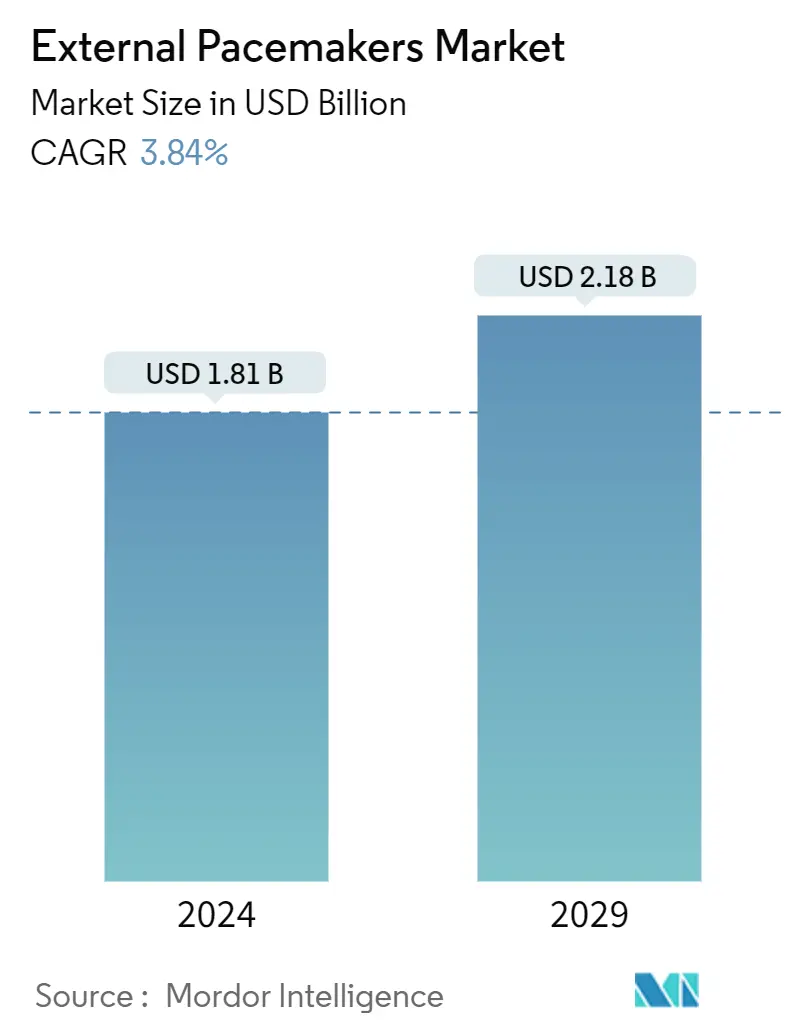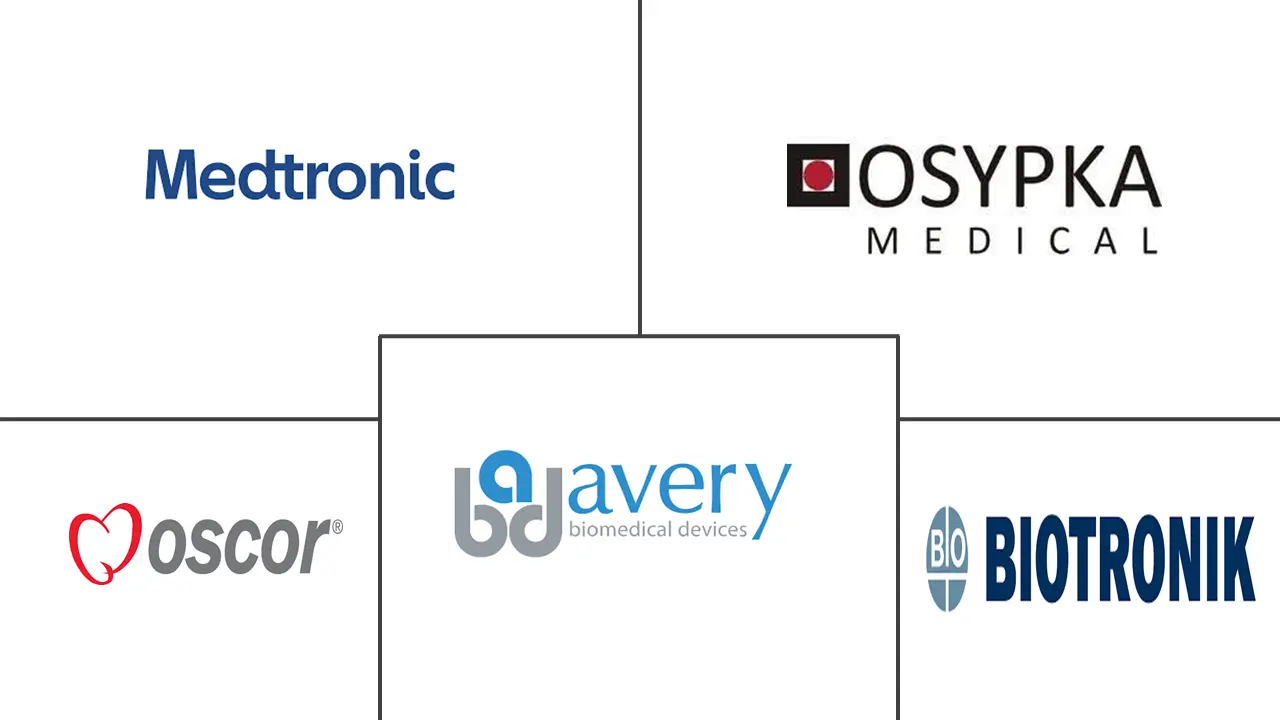Market Size of External Pacemakers Industry

| Study Period | 2018-2029 |
| Market Size (2024) | USD 1.81 Billion |
| Market Size (2029) | USD 2.18 Billion |
| CAGR (2024 - 2029) | 3.84 % |
| Fastest Growing Market | Asia Pacific |
| Largest Market | North America |
| Market Concentration | High |
Major Players
*Disclaimer: Major Players sorted in no particular order |
External Pacemakers Market Analysis
The External Pacemakers Market size is estimated at USD 1.81 billion in 2024, and is expected to reach USD 2.18 billion by 2029, growing at a CAGR of 3.84% during the forecast period (2024-2029).
The external pacemakers market was significantly impacted during the COVID-19 pandemic owing to a decrease in elective procedures and non-urgent medical device implantations, including external pacemakers. Moreover, various disruptions, including supply chain issues and manufacturing challenges, significantly impacted the manufacturing and distribution of external pacemakers, which has also affected the delivery of timely solutions to patients. According to the Journal of Arrhythmia from NIH published in February 2022, COVID-19 significantly impacted the temporary pacemaker usage rates during the first wave of COVID-19. Still, later, the implication of external pacemaker devices increased remarkably owing to the surging trend of remote monitoring.
According to Sociedad Española de Cardiología (Spanish Society of Cardiology) data of August 2023, the remote monitoring of cardiac implantable electronic devices increased exponentially post-lockdown period and shifted a trend of cardiac monitoring. Thus, the pandemic has had a mixed impact on the external pacemaker market, and the industry is likely to have lucrative growth opportunities in the coming years due to the rising disease burden and high penetration of telemedicine.
The increasing burden of cardiovascular conditions coupled with several risks associated with cardiovascular diseases (CVDs) is driving the global external pacemakers market. Some of the most important risk factors contributing to the higher burden of CVDs include a sedentary lifestyle, physical inactivity, and a surge in an aging population. According to WHO’s data of September 2023, cardiovascular diseases are the leading cause of death across the world, and an estimated 17.9 million people die from it every year. Moreover, more than four out of five cardiovascular disease deaths are owing to stroke and heart failure, which mainly occur from arrhythmia and irregular heart rate. This expanding patient pool, along with the higher need for precise cardiac care, has created a robust demand for various cardiac devices, including external pacemakers, thereby fostering the market opportunity for manufacturers.
Moreover, rising demand for temporary pacemakers owing to several benefits like non-invasive pacing, convenient operation, and leveraging clinical significance has created a high demand across end-users like hospitals, clinician’s offices, and ambulatory surgery centers. For instance, various kinds of conduction abnormalities, including ventricular tachycardia and bradycardia, can be typically managed with an external pacing system until tailored treatment is developed. In addition, the external pacing system has also been found useful in reversing conditions like myocardial infarction and drug-induced electrical disturbances. For instance, according to the National Center of Biotechnology Information’s data from September 2022, external pacing is the fastest and most convenient method to manage emergencies and rhythm disorders like tachycardia and bradycardia. Thus, the ability of external pacing systems to maintain adequate cardiac output in emergencies has facilitated their demand across end-users like hospitals, ambulatory surgical centers, and clinics.
In addition, the increasing geriatric population globally and the presence of various public and private organizations promoting awareness regarding CVDs and arrhythmia are further supporting the global market. For instance, the World Heart Federation is a leading non-governmental organization (NGO) engaged in creating awareness regarding CVDs around the globe in partnership with the WHO.
Also, the surging elderly population, especially those over age 65, are more susceptible to heart rhythm-related disorders, and they often need an external pacing system to maintain a regular heart rate. According to Statistics Canada, in July 2022, over 7.33 million Canadians were aged more than 65 years and older, and the country’s elderly population is projected to grow by 68% over the next 20 years. There is a close relationship between the elderly population and the risk of developing CVD. Hence, the growing elderly population is projected to create a high demand for external pacing systems in the near future. For instance, according to the European Heart Journal published in December 2022, temporary pacemakers can be utilized in elderly patients to achieve atrioventricular synchronous pacing.
Furthermore, technological advancements have made these pacemakers more efficient and user-friendly, thereby bolstering their adoption. Moreover, the evolving disease landscape and high demand for advanced external pacing systems have facilitated manufacturers to develop advanced and precise pacing solutions. For instance, in July 2023, BIOTRONIK received U.S. FDA approval for its next-generation family of pacemakers. This pacemaker family of the company also comprises Amvia Edge, the industry’s smallest single-chamber MR (magnetic resonance) conditional pacemaker for best patient-centric outcomes. This approval marked a significant step in cardiac pacing platforms.
However, factors such as the higher cost of external pacing devices and stringent regulatory frameworks are anticipated to hamper industry growth over the forecast period.
External Pacemakers Industry Segmentation
As per the scope of the report, an external pacemaker or temporary pacemaker is an electrode-based device that is used to regulate heart rhythm and a normal heart rate. The external pacemakers market is segmented by product (single chamber and dual chamber), application (bradycardia, acute myocardial infarction, and other applications), end-user (hospitals, ambulatory surgical centers, and other end-users), and geography (North America, Europe, Asia-Pacific, the Middle East and Africa, and South America). The market report also covers the estimated market sizes and trends for 17 different countries across major regions globally.
The report offers the value (in USD) for the above segments.
| By Product | |
| Single Chamber | |
| Dual Chamber |
| By Application | |
| Bradycardia | |
| Acute Myocardial Infarction | |
| Other Applications |
| By End-Users | |
| Hospitals | |
| Ambulatory Surgical Centers | |
| Other End-Users |
| Geography | ||||||||
| ||||||||
| ||||||||
| ||||||||
| ||||||||
|
External Pacemakers Market Size Summary
The external pacemakers market is poised for growth, driven by the increasing prevalence of cardiovascular diseases and the rising geriatric population globally. The market experienced disruptions during the COVID-19 pandemic, which affected elective procedures and supply chains, but has since seen a resurgence due to the growing trend of remote monitoring and telemedicine. The demand for external pacemakers is further bolstered by the need for precise cardiac care, as cardiovascular diseases remain a leading cause of mortality worldwide. Technological advancements have made these devices more efficient and user-friendly, enhancing their adoption across various healthcare settings, including hospitals and ambulatory surgery centers. The market is characterized by a robust demand for dual-chamber pacemakers, which offer benefits such as synchronized pacing and suitability for a wide range of heart conditions, thereby supporting their continued dominance in the market.
North America is expected to lead the external pacemakers market, supported by a high prevalence of heart conditions, a significant elderly population, and a strong presence of key market players. The region benefits from a favorable regulatory and reimbursement framework, which encourages the adoption of advanced cardiac devices. The competitive landscape is moderately consolidated, with several international and regional companies, including Medtronic and BIOTRONIK, holding significant market shares. The market's growth is further supported by strategic partnerships and product innovations, such as the development of minimally invasive pacing systems. Despite challenges like high device costs and stringent regulations, the market is anticipated to expand, driven by the increasing demand for external pacing solutions and the ongoing advancements in cardiac technology.
External Pacemakers Market Market Size - Table of Contents
-
1. MARKET DYNAMICS
-
1.1 Market Overview
-
1.2 Market Drivers
-
1.2.1 Increasing Prevalence of Cardiovascular Diseases
-
1.2.2 Technological Advancements in Pacemakers
-
1.2.3 Growing Geriatric Population
-
-
1.3 Market Restraints
-
1.3.1 Stringent Regulatory Framework
-
1.3.2 High Cost of the Devices
-
-
1.4 Porter's Five Forces Analysis
-
1.4.1 Bargaining Power of Suppliers
-
1.4.2 Bargaining Power of Buyers/Consumers
-
1.4.3 Threat of New Entrants
-
1.4.4 Threat of Substitute Products
-
1.4.5 Intensity of Competitive Rivalry
-
-
-
2. MARKET SEGMENTATION (Market Size by Value - USD)
-
2.1 By Product
-
2.1.1 Single Chamber
-
2.1.2 Dual Chamber
-
-
2.2 By Application
-
2.2.1 Bradycardia
-
2.2.2 Acute Myocardial Infarction
-
2.2.3 Other Applications
-
-
2.3 By End-Users
-
2.3.1 Hospitals
-
2.3.2 Ambulatory Surgical Centers
-
2.3.3 Other End-Users
-
-
2.4 Geography
-
2.4.1 North America
-
2.4.1.1 United States
-
2.4.1.2 Canada
-
2.4.1.3 Mexico
-
-
2.4.2 Europe
-
2.4.2.1 Germany
-
2.4.2.2 United Kingdom
-
2.4.2.3 France
-
2.4.2.4 Italy
-
2.4.2.5 Spain
-
2.4.2.6 Rest of Europe
-
-
2.4.3 Asia-Pacific
-
2.4.3.1 China
-
2.4.3.2 Japan
-
2.4.3.3 India
-
2.4.3.4 Australia
-
2.4.3.5 South Korea
-
2.4.3.6 Rest of Asia-Pacific
-
-
2.4.4 Middle East and Africa
-
2.4.4.1 GCC
-
2.4.4.2 South Africa
-
2.4.4.3 Rest of Middle East and Africa
-
-
2.4.5 South America
-
2.4.5.1 Brazil
-
2.4.5.2 Argentina
-
2.4.5.3 Rest of South America
-
-
-
External Pacemakers Market Market Size FAQs
How big is the External Pacemakers Market?
The External Pacemakers Market size is expected to reach USD 1.81 billion in 2024 and grow at a CAGR of 3.84% to reach USD 2.18 billion by 2029.
What is the current External Pacemakers Market size?
In 2024, the External Pacemakers Market size is expected to reach USD 1.81 billion.

